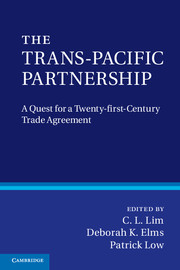Book contents
- Frontmatter
- Contents
- List of Figures and Tables
- Contributors
- Preface
- Acknowledgements
- Disclaimer
- Glossary
- Part I Introduction
- Part II The past: origins of the TPP Agreement
- Part III The present: twenty-first century elements and obstacles
- 6 Negotiations over market access in goods
- 7 TPP negotiations
- 8 Trade in services
- 9 TPP Agreement
- 10 The intellectual property chapter in the TPP
- 11 Regulatory coherence in the TPP talks
- 12 Environmental issues in the TPP
- 13 Labour standards and the TPP
- 14 What is to be done with export restrictions?
- Part IV The future: high-quality meets regional and global realities
- Part V The TPP negotiations: the quest for quality
- Index
- References
14 - What is to be done with export restrictions?
Published online by Cambridge University Press: 05 November 2012
- Frontmatter
- Contents
- List of Figures and Tables
- Contributors
- Preface
- Acknowledgements
- Disclaimer
- Glossary
- Part I Introduction
- Part II The past: origins of the TPP Agreement
- Part III The present: twenty-first century elements and obstacles
- 6 Negotiations over market access in goods
- 7 TPP negotiations
- 8 Trade in services
- 9 TPP Agreement
- 10 The intellectual property chapter in the TPP
- 11 Regulatory coherence in the TPP talks
- 12 Environmental issues in the TPP
- 13 Labour standards and the TPP
- 14 What is to be done with export restrictions?
- Part IV The future: high-quality meets regional and global realities
- Part V The TPP negotiations: the quest for quality
- Index
- References
Summary
Introduction
Restrictions on market access and on supplies can be equally trade distortive. But while the trade policy community has spent more than sixty years since the GATT’s establishment exploring ways in which greater market access might be achieved worldwide, and therefore examining the regulation of restrictions on imports, it has neglected the need to refine the rules on export restrictions. That may not be surprising, but the idea that the TPP – touted as a “high-quality, twenty-first century agreement” – can ignore the issue would be. Concerns about access to commodities and food security, as well as trade friction over Chinese restrictions on rare earths exports have dominated headlines in the past year. The problems here lies, partly, in the absence of strong rules that prevent restrictions on exports, be they rare earths or rice. We are therefore entitled to expect the TPP members, and not just the United States, to do something about the issue. Instead, what is remarkable is its lack of visibility in the TPP negotiations to date, in comparison with other issues. We have not seen, for example, a separate chapter on export restrictions as of November 2011, notwithstanding the global attention which rare earths and food security have attracted recently. Could there be a better twenty-first century topic than this one? Export restrictions are the first thing I would have placed on the agenda. In any case, no “twenty-first century agreement” can afford to ignore the subject.
Instead of the usual focus on import restrictions and the traditional preoccupation with gaining market access, we will therefore turn to the question of ensuring future access to supplies (commodities, food, etc.),and to concerns with the production relocation effects of export taxes and other restrictions.
Information
- Type
- Chapter
- Information
- The Trans-Pacific PartnershipA Quest for a Twenty-first Century Trade Agreement, pp. 211 - 220Publisher: Cambridge University PressPrint publication year: 2012
